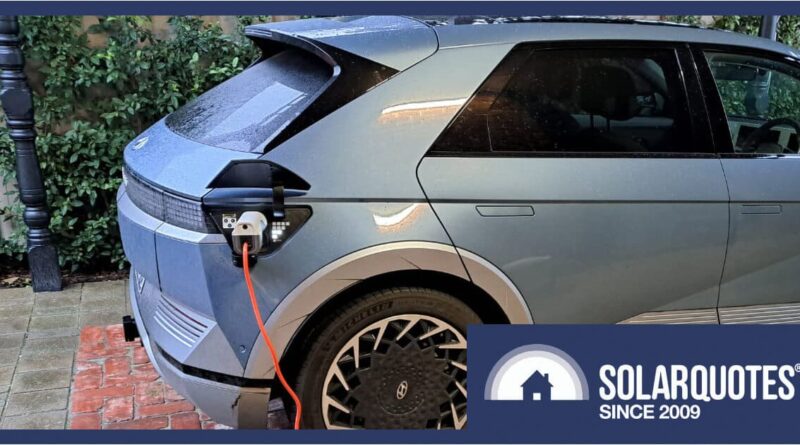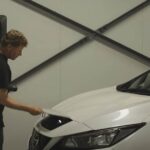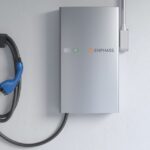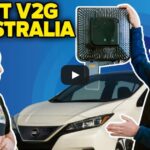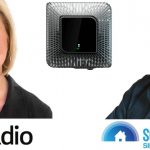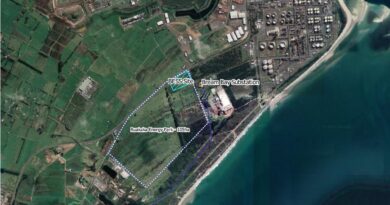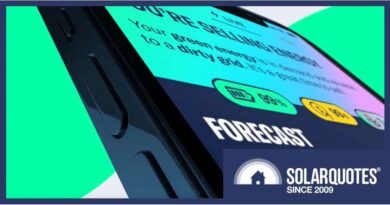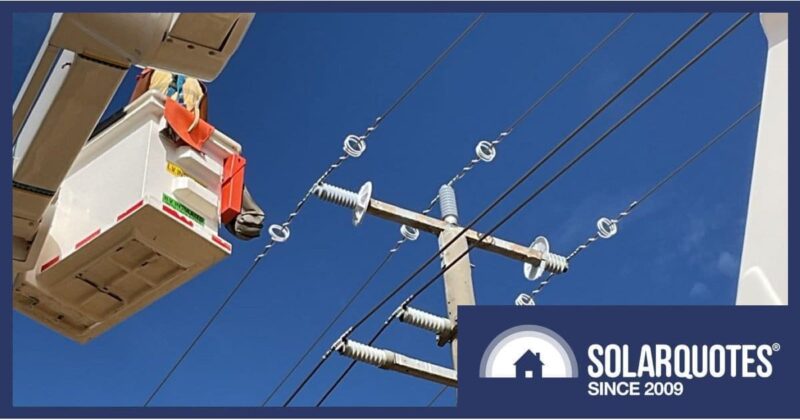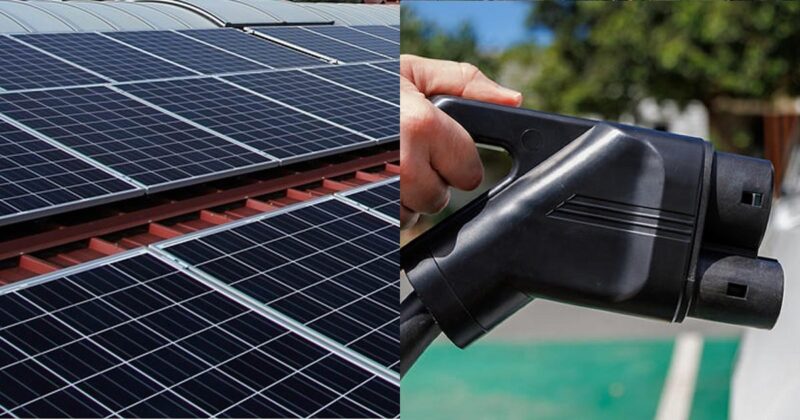HOEM Device Converts V2L Cars To V2H – For Under $1,000
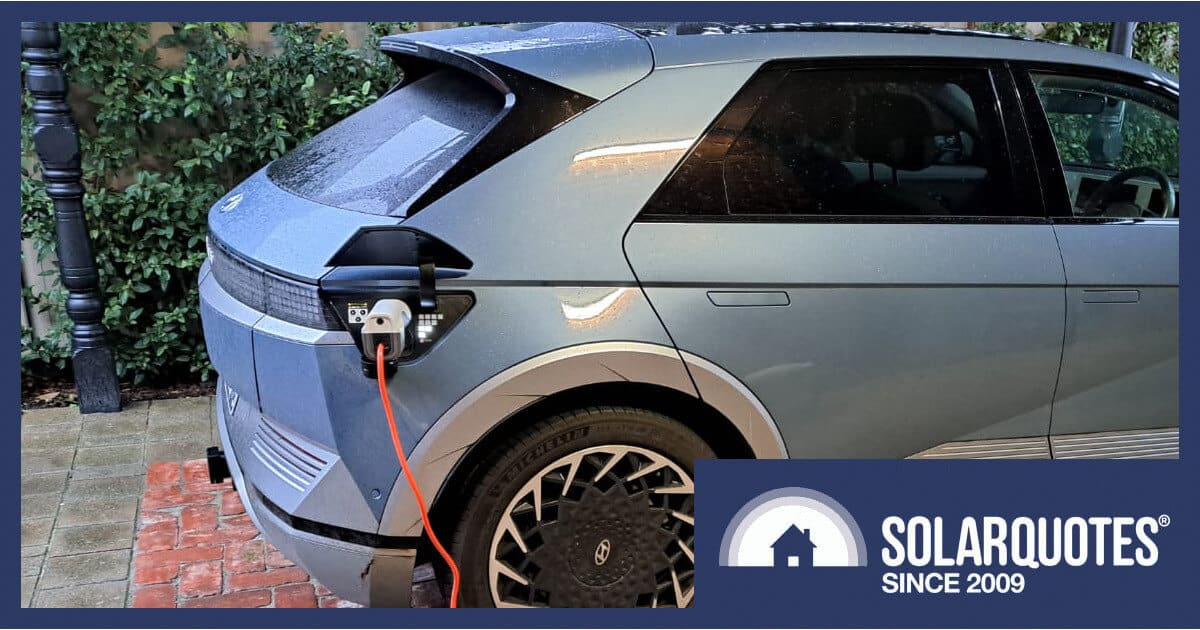
Many Australians are having an epiphany: electric vehicles are big batteries on wheels that could, in theory, be used to power our homes using a V2H (Vehicle to Home) system.
However, only one full EV currently does this: the ageing Nissan Leaf Gen 2. Moreover, only one home EV charger is compatible with the Nissan Leaf’s V2H system – the Wallbox Quasar. And that’s been discontinued.
So, V2H in Australia is seemingly impossible right now. Or is it?
An increasing number of EVs1 let you power a load through the car’s charging port (V2L).
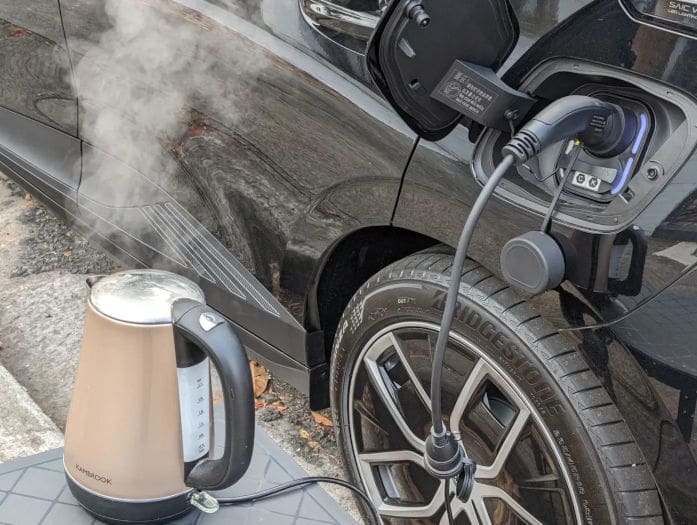
Old MGs (like any pommy car in Australia), used to just to boil the radiator. New models have new solutions. Image credit: Neerav Bhatt.
What if we could buy a device that converted V2L cars to V2H?
The HOEM (Home Open Energy Manager) is a device that promises to do just this, but what exactly does it do, and is it legal to use? Read on to find out. But first, let’s make sure we understand the bidirectional jargon.
Know Your Acronyms
V2G = Vehicle to Grid
V2G is bi-directional charging, where you can charge your car quickly; and discharge energy to support major loads in your house.
Previously, if you had a Nissan Leaf and lived in South Australia, the Wallbox Quasar was an approved solution. However, it was not a grid-forming inverter, so it didn’t work during a grid outage, which was a hard pill to swallow for something that cost $10,000+
V2L = Vehicle to Load
V2L offers a flexible supply from your car to almost anything.
From a modest few hundred watts—ideal for charging gadgets—to heftier outputs like 2kW or 3.6kW (8 to 15 amps), it can be as gutsy as a standard power point to run small appliances or even a kettle, provided there are no large surge loads.
Imagine V2L as a camping generator. It’s legal to use in the same fashion, but quieter and without the lethal fumes.
V2H = Vehicle to Home
There’s a crossover between V2G and V2H, which arguably hinges on the inverter’s location—either mounted on your house wall or integrated into your vehicle.
For this discussion, we’ll define V2H as the wiring that allows you to power your house using the V2L inverter in your car.
The setup is the same as running a little Rhonda generator to power a caravan: you’ll have a 15amp inlet socket with some essential circuits devoted to it.
It won’t be capable of running larger loads like ducted aircon or a rainwater pressure pump. For that, you’d need a diesel generator the size of your dining table (and perhaps a 32-amp socket)
Why V2L Can’t Directly Power Your Home
You can’t plug a V2L car directly into an Australian switchboard if there’s an earth leakage safety feature in the EV’s V2L output. The car’s safety mechanism interprets the home’s Multiple Earth Neutral (MEN link) connection as a hard earth fault, preventing the system from operating.
How Does HOEM Work?
The HOEM is a socket inlet on your home wired to a HOEM sub-board installed near your existing switchboard.
HOEM will not power your whole home. It is designed to power a small number of circuits that won’t overload the car’s modest V2L power limit.
The HOEM device uses a clever combination of off-the-shelf components. Primarily, a changeover contactor swaps your selected circuits away from the grid supply and onto the car’s V2L output.
The onboard inverter in a car is a limited source, so there is also an AS4755 load-sensing relay.
This relay is adjusted to your vehicle’s specifications. Should household demand surpass what your car can provide, it temporarily drops off non-essential circuits. So when you put the kettle on, the V2L inverter doesn’t cut out, and you don’t have to trail out to the garage to reset the V2L supply.
HOEM call this ‘V2HL’.
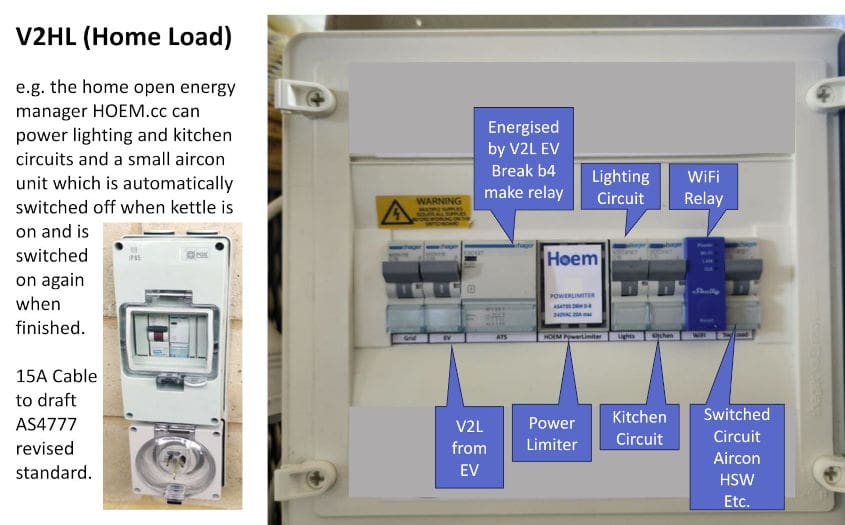
5amp socket inlet on the left, HOEM device on the right
Hallelujah, There Is No App
Connectivity for HOEM consists of an extension cord. That’s it. No internet, no app, no worries.
Integration involves activating the V2L supply on your vehicle and simply plugging the cord in.
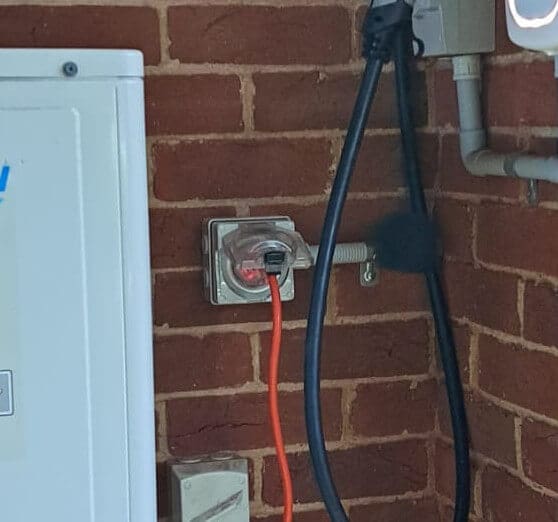
Simply plug the cord into your house…
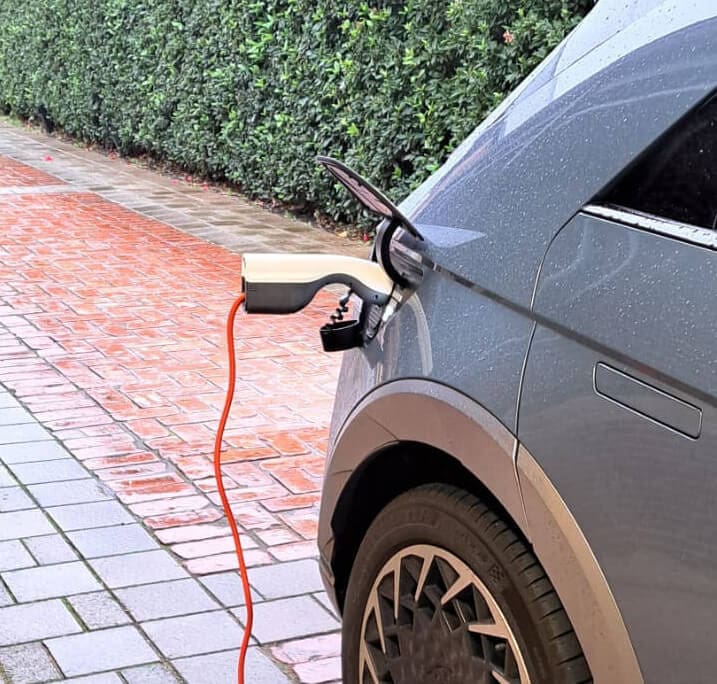
…and into the car.
If the car battery runs down to the point it should disconnect the V2L inverter, the HOEM device will default to ordinary mains supply.
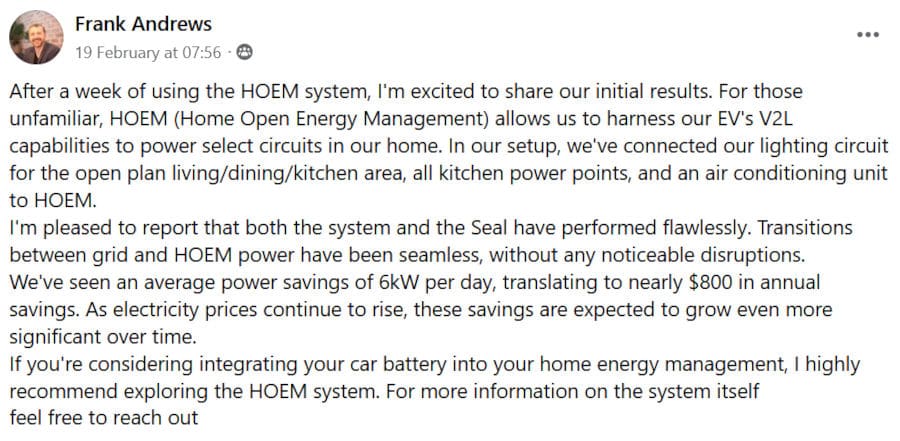
There are already happy campers out there (I’m assuming Frank means energy bill savings of 6kWh per day)
It Is Legal, Isn’t It?
The HOEM device has instructions for your electrician using drawings extracted from AS3010, so it’s compliant with a conventional generator inlet socket and changeover switch arrangement.
It’s also compliant with the upcoming AS4777 standard for alternate supplies from inverters, once it’s formally adopted.
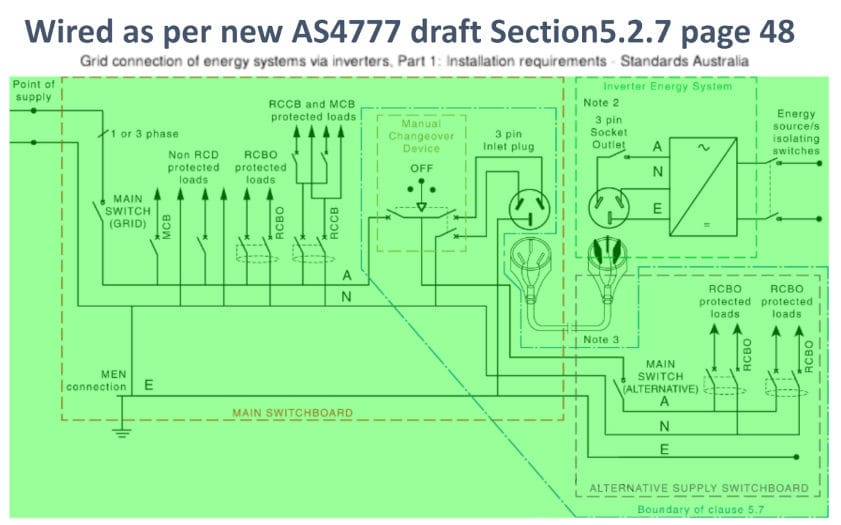
New AS4777 standards should solve some problems.
Installation Is Flexible
The HOEM device is supplied as a kit, meaning you and your electrician can decide to bolt on externally or seamlessly integrate the parts.
The car may supply 2kW to 3.5kW, whereas the average house has 14.5 kW available from the street. So you’ll also have to decide what’s essential and what will save you the most money overnight.
Extended Capacity With Smart Energy Sharing
Typically, this type of modest backup system would power your lights and fridge, but HOEM allows you to choose an extra circuit — a small air conditioner or pool pump, for example. This non-essential circuit will drop out temporarily if the V2L function is overloaded.
There is also scope for a WiFi-controlled relay, allowing remote switching, timer functions, or a kWh meter so you can track your savings.
HOEM Will Sell Like Hotcakes
The HOEM device costs about $900, less than 10% of a Wallbox Quasar bidirectional charger.
Installation could be $300 or $3000, depending on where your car is parked and if you need a dedicated wiring run for appliance(s) you want to run off the car.
While any competent electrician should be able, my advice would be to engage a savvy home automation expert and take the opportunity to overhaul your switchboard for solar, consumption monitoring and hot water diversion too.
The Take HOEM Message
Electrically, the solution on offer here is super simple.
Technically, it’s switching less than 20amps, so there are no network compliance problems.
Ethically, the people selling it aren’t trying to patent the idea to make a motza; rather, they use a “cc” web domain to raise awareness about Cocos Islands, Australia’s most climate change-vulnerable territory.
If you can charge at work and come home with a near-full battery every night, you can run the house on the stored sunshine and use the company fuel while avoiding peak evening rates.
HOEM makes it easy to save money day-to-day, but it’s when things go pear-shaped — when there are grid outages due to fire, flood or other disaster — the benefits will be priceless.
If you are interested in HOEM, their website isn’t great – your best bet is to call Russell on 0418 810 205 or email [email protected]
Footnotes
- but not Teslas – unless you have a Cybertruck ↩
Original Source: https://www.solarquotes.com.au/blog/hoem-review/

